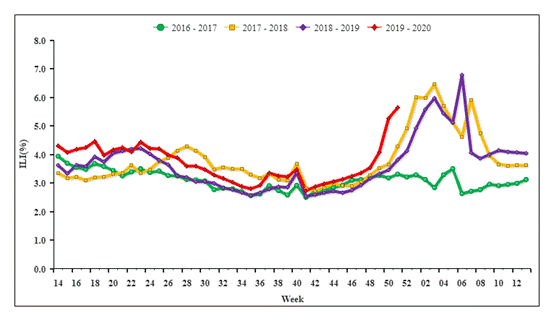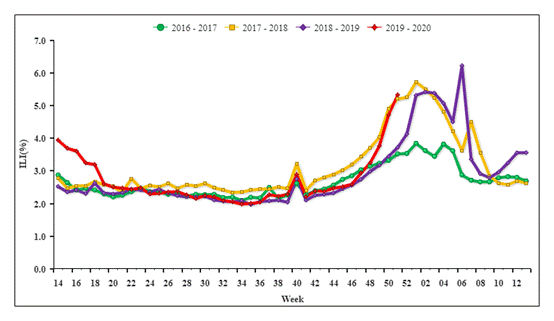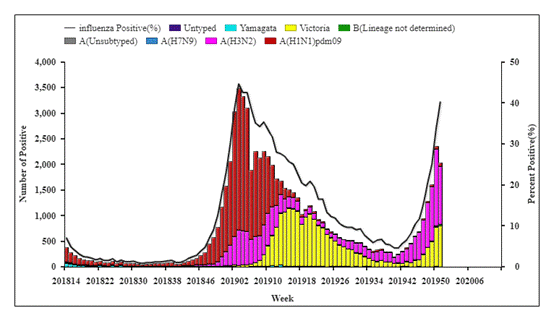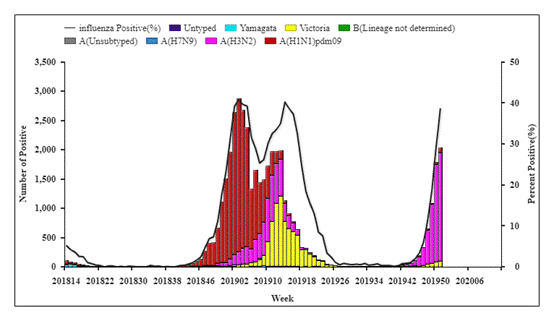Weekly Report
Week 51 2019
Article source: Date time:2019-12-27
Download:China flu report 1951.pdf
Chinese Influenza Weekly Report
(All data are preliminary and may change as more reports are received)
|
Summary l Among influenza viruses antigenically characterized by CNIC since April 1st, 2019, 1611(97.9%) influenza A(H1N1)pdm09 viruses were characterized as A/Brisbane/02/2018-like; 192(21.9%) influenza A(H3N2) viruses were characterized as A/Kansas/14/2017 (EGG)-like, 294(34.9%) influenza A(H3N2) viruses were characterized as A/Kansas/14/2017 (CELL)-like; 646(39.0%) influenza B/Victoria viruses were characterized as B/Colorado/06/2017-like; 16(94.1%) influenza B/Yamagata viruses were characterized as B/Phuket/3073/2013-like. l Among the influenza viruses tested by CNIC for antiviral resistance analysis since April 1st, 2019, all influenza A(H1N1)pdm09 and A(H3N2) viruses were resistant to adamantine; All influenza A(H3N2) and B viruses were sensitive to neuraminidase inhibitors. All but 1 influenza A(H1N1)pdm09 were sensitive to neuraminidase inhibitors. |
Surveillance of outpatient or emergency visits for Influenza-like Illness (ILI)
During week 51 (Dec 16th 2019 –Dec 22nd 2019), the percentage of outpatient or emergency visits for ILI (ILI%) at national sentinel hospitals in southern provinces was 5.6%, higher than the last week (5.3%), higher than the same week of 2016-2018 (3.3%, 4.3% and 3.8%). (Figure 1)

Figure 1. Percentage of Visits for ILI at Sentinel Hospitalsin South China
(2016-2020)
During week 51, ILI% at national sentinel hospitals in northern provinces was 5.3%, higher than the last week (4.7%), higher than the same week of 2016-2018 (3.5%, 5.2% and 3.7%). (Figure 2)

Figure 2. Percentage of Visits for ILI at Sentinel Hospitals in North China
(2016-2020)
Virologic Surveillance
During week 51, influenza network laboratories tested 10300 specimens, of which 4055 (39.4%) were positive for influenza, influenza A and influenza B viruses were 3131 (77.2%) and 924 (22.8%), respectively (Table 1). During week 51, the percentage of specimens that were tested positive for influenza in south China was 40.2%, which was higher than the previous week (33.7%) (Figure 3). During week 51, the percentage of specimens that were tested positive for influenza in north China was 38.5%, which was higher than the previous week (29.3%). (Figure 4).
Table 1 Laboratory Detections of ILI Specimens (Week 51, 2019)
|
|
Week 51 |
||
|
South China |
North China |
Total |
|
|
No. of specimens tested |
5034 |
5266 |
10300 |
|
No. of positive specimens (%) |
2025(40.2%) |
2030(38.5%) |
4055(39.4%) |
|
Influenza A |
1201(59.3%) |
1930(95.1%) |
3131(77.2%) |
|
A(H3N2) |
1137 |
1850 |
2987 |
|
A(H1N1)pdm09 |
63 |
80 |
143 |
|
A (subtype not determined) |
1 |
0 |
1 |
|
Influenza B |
824(40.7%) |
100(4.9%) |
924(22.8%) |
|
B (lineage not determined) |
20 |
0 |
20 |
|
Victoria |
804 |
99 |
903 |
|
Yamagata |
0 |
1 |
|

Figure 3. Influenza Positive Tests Reported by Southern Network Laboratories (Week 14, 2018–Week 51, 2019)
Note: Analysis in this part was based on the test results of network laboratories. If it were not consistent with the results of CNIC confirmation, the results of CNIC confirmation were used.

Figure 4. Influenza Positive Tests Reported by Northern Network Laboratories (Week 14, 2018–Week 51, 2019)
Note: Analysis in this part was based on the result of network laboratories. If it were not consistent with the results of CNIC confirmation, the results of CNIC confirmation were used.
Antigenic Characterization
Since April 1st, 2019, 1611(97.9%) influenza A(H1N1)pdm09 viruses were characterized as A/Brisbane/02/2018-like; 192(21.9%) influenza A(H3N2) viruses were characterized as A/Kansas/14/2017 (EGG)-like, 294(34.9%) influenza A(H3N2) viruses were characterized as A/Kansas/14/2017 (CELL)-like; 646(39.0%) influenza B/Victoria viruses were characterized as B/Colorado/06/2017-like; 16(94.1%) influenza B/Yamagata viruses were characterized as B/Phuket/3073/2013-like.
Antiviral Resistance
Since April 1st, 2019, among the influenza viruses tested by CNIC for antiviral resistance, all influenza A(H1N1)pdm09 and A(H3N2) viruses were resistant to adamantine; All influenza A(H3N2) and B viruses were sensitive to neuraminidase inhibitors. All but 1 influenza A(H1N1)pdm09 were sensitive to neuraminidase inhibitors.
Outbreak Surveillance
During week 51 (Dec 16th 2019- Dec 22nd 2019), There were six hundred and forty-five outbreaks reported nationwide, three hundred and fifty-seven of them were A(H3N2), four of them were H1N1pdm, seven of them were A(lineage not determined),ninety-four of them were B(Victoria), thirteen of them were B(lineage not determined), seventy of them were mixed, twelve of them were flu negative, eighty-eight of them had not been obtained the testing results.
H7N9 Case Report
During week 51, no new human infection with novel reassortant influenza A(H7N9) virus was reported.

